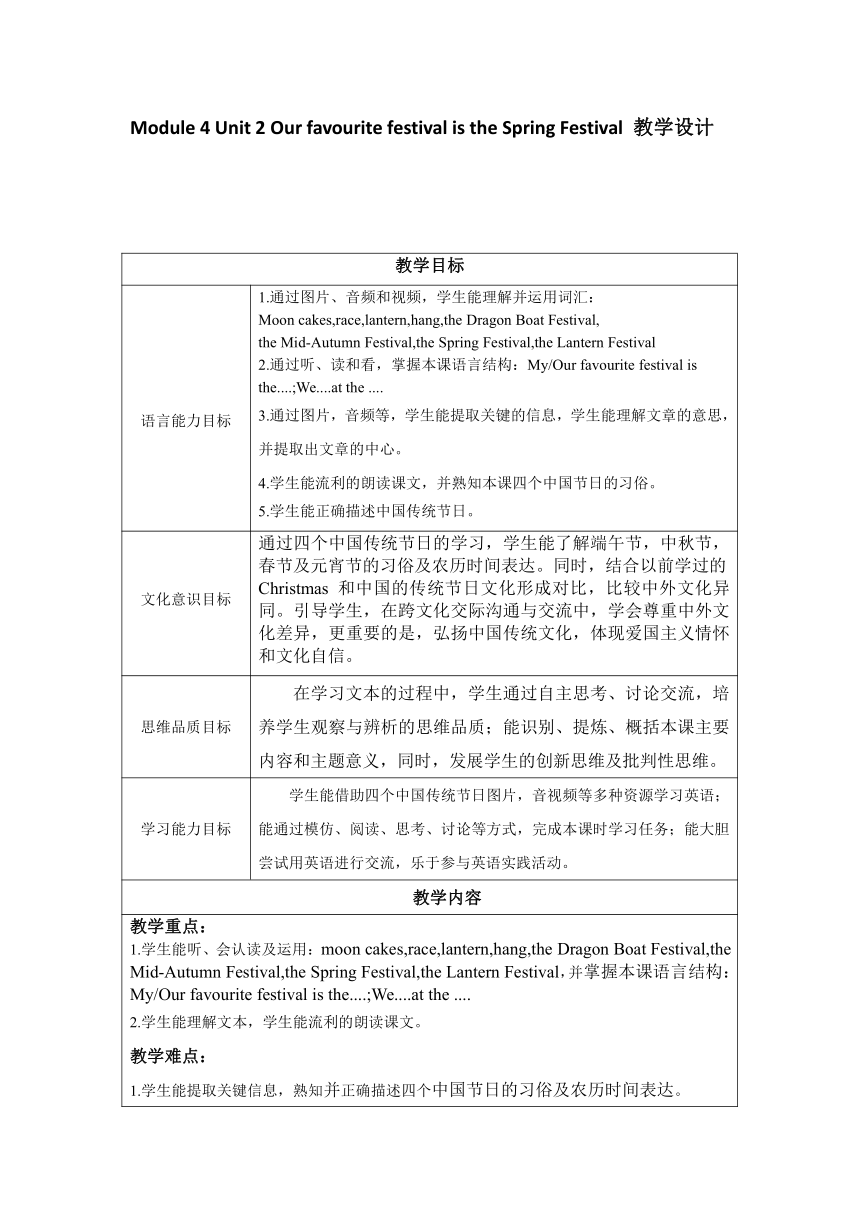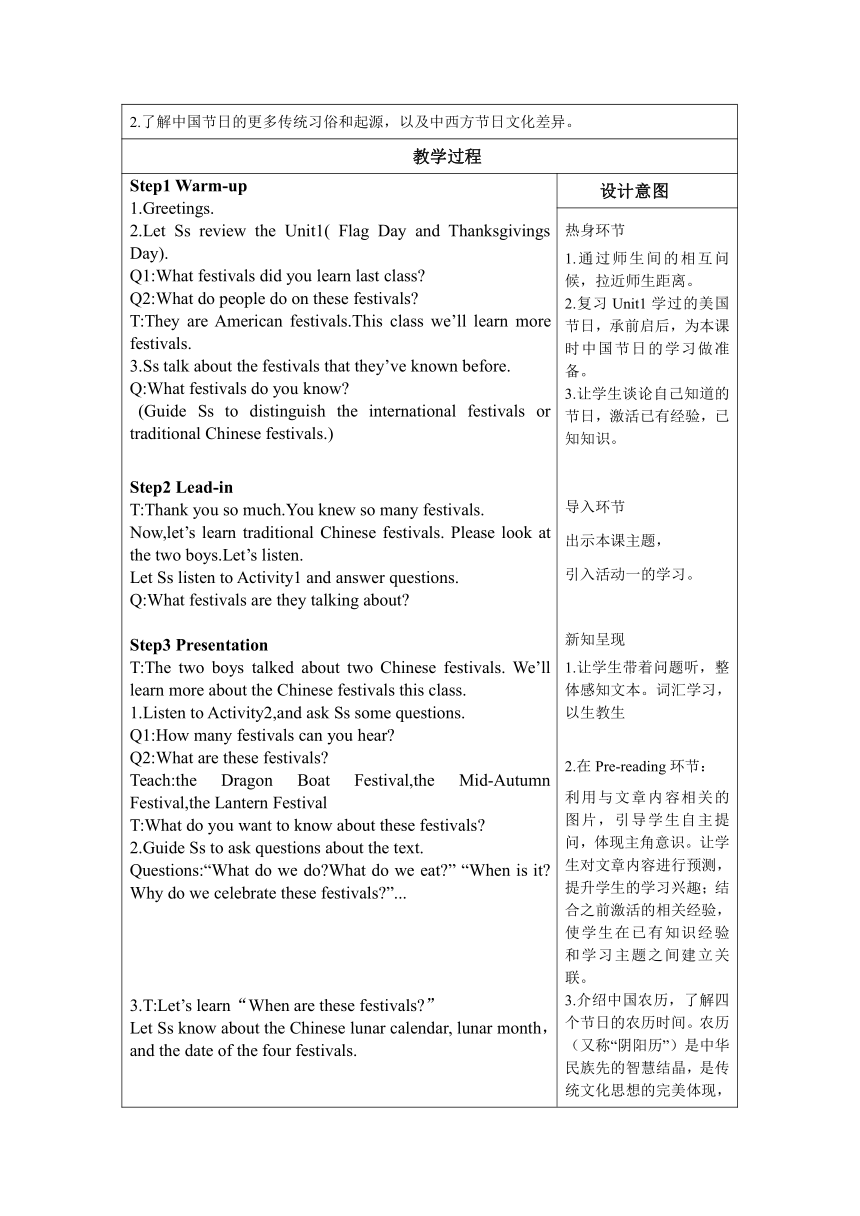Module 4 Unit 2 Our favourite festival is the Spring Festival表格式教学设计
文档属性
| 名称 | Module 4 Unit 2 Our favourite festival is the Spring Festival表格式教学设计 |  | |
| 格式 | zip | ||
| 文件大小 | 24.8KB | ||
| 资源类型 | 教案 | ||
| 版本资源 | 外研版(三年级起点) | ||
| 科目 | 英语 | ||
| 更新时间 | 2023-05-03 16:24:39 | ||
图片预览


文档简介
Module 4 Unit 2 Our favourite festival is the Spring Festival 教学设计
教学目标
语言能力目标 1.通过图片、音频和视频,学生能理解并运用词汇: Moon cakes,race,lantern,hang,the Dragon Boat Festival, the Mid-Autumn Festival,the Spring Festival,the Lantern Festival 2.通过听、读和看,掌握本课语言结构:My/Our favourite festival is the....;We....at the .... 3.通过图片,音频等,学生能提取关键的信息,学生能理解文章的意思,并提取出文章的中心。 4.学生能流利的朗读课文,并熟知本课四个中国节日的习俗。 5.学生能正确描述中国传统节日。
文化意识目标 通过四个中国传统节日的学习,学生能了解端午节,中秋节,春节及元宵节的习俗及农历时间表达。同时,结合以前学过的Christmas 和中国的传统节日文化形成对比,比较中外文化异同。引导学生,在跨文化交际沟通与交流中,学会尊重中外文化差异,更重要的是,弘扬中国传统文化,体现爱国主义情怀和文化自信。
思维品质目标 在学习文本的过程中,学生通过自主思考、讨论交流,培养学生观察与辨析的思维品质;能识别、提炼、概括本课主要内容和主题意义,同时,发展学生的创新思维及批判性思维。
学习能力目标 学生能借助四个中国传统节日图片,音视频等多种资源学习英语;能通过模仿、阅读、思考、讨论等方式,完成本课时学习任务;能大胆尝试用英语进行交流,乐于参与英语实践活动。
教学内容
教学重点: 1.学生能听、会认读及运用:moon cakes,race,lantern,hang,the Dragon Boat Festival,the Mid-Autumn Festival,the Spring Festival,the Lantern Festival,并掌握本课语言结构:My/Our favourite festival is the....;We....at the .... 2.学生能理解文本,学生能流利的朗读课文。 教学难点: 1.学生能提取关键信息,熟知并正确描述四个中国节日的习俗及农历时间表达。 2.了解中国节日的更多传统习俗和起源,以及中西方节日文化差异。
教学过程
Step1 Warm-up 1.Greetings. 2.Let Ss review the Unit1( Flag Day and Thanksgivings Day). Q1:What festivals did you learn last class Q2:What do people do on these festivals T:They are American festivals.This class we’ll learn more festivals. 3.Ss talk about the festivals that they’ve known before. Q:What festivals do you know (Guide Ss to distinguish the international festivals or traditional Chinese festivals.) Step2 Lead-in T:Thank you so much.You knew so many festivals. Now,let’s learn traditional Chinese festivals. Please look at the two boys.Let’s listen. Let Ss listen to Activity1 and answer questions. Q:What festivals are they talking about Step3 Presentation T:The two boys talked about two Chinese festivals. We’ll learn more about the Chinese festivals this class. 1.Listen to Activity2,and ask Ss some questions. Q1:How many festivals can you hear Q2:What are these festivals Teach:the Dragon Boat Festival,the Mid-Autumn Festival,the Lantern Festival T:What do you want to know about these festivals 2.Guide Ss to ask questions about the text. Questions:“What do we do What do we eat ” “When is it Why do we celebrate these festivals ”... 3.T:Let’s learn“When are these festivals ” Let Ss know about the Chinese lunar calendar, lunar month,and the date of the four festivals. 4.T:Now,let’s learn “What do we eat at these festival ” Guide Ss to know about the food in these festivals. 5.Ss read the Activity2 and find out the answers by themselves . Then, let Ss complete the table and write key words. Listen and check the answers.Meanwhile,let Ss focus on the sound of the words. Ask Ss to talk about the answers according to their table. At the same time,T guide Ss to learn the details of the text. The Dragon Boat Festival Q1:What do we do Q2: What other customs do you know Show some pictures to let Ss know more traditional customs of this festivals. Learn:race(show a video of the dragon boat race) Q3:Why do we celebrate this festival T guide Ss to learn the story about Qu yuan. The Mid-Autumn Festival Show the picture and let Ss answer. Q1:What do we do Q2: What other customs do you know Let Ss think about Q4:What’s the meaning of this festival T:Just as the poem诗 says, people express the expectation for the full moon(对月圆期盼) and their love for families and friends at this festival. The Lantern Festival Q1:What do we do Q2:What else do we do Teach:lantern, hang (Ss learn more traditional customs at the Lantern Festival.) The Spring Festival Q1:What do you do at the Spring Festival Q2:What do we say T:We say “Happy Chinese New Year!” In Chinese, we say “Guo Nian”.Q3:What is “Nian” Show the video of the history of the Spring Festival.Ask Ss think and answer the following questions . Q1:What is “Nian ” Q2:What things are the monster afraid of Q3:How did people drive it out of the village T:So,now “What else do you do at the Spring Festival ”(Ss learn more traditional customs at the Spring Festival.) 6.Think&discuss:The similarities and the differences between Spring Festival and Christmas 7.T:Now,you know many customs and the time of these festivals.Do you remember“What’s the girl/mum/dad/the family’s/boy’s favourite festivals ” Ss watch the flash of Activity2, let them think and answer. Step4 Practise 8.Q:What’s your favorite festival Why What do you do at...festival Work in groups and give you 3mins.And talk about your favourite festival. T:Can you share your favourite festival Step5 Summary Summarize the text. 设计意图
热身环节 1.通过师生间的相互问候,拉近师生距离。 2.复习Unit1学过的美国节日,承前启后,为本课时中国节日的学习做准备。 3.让学生谈论自己知道的节日,激活已有经验,已知知识。 导入环节 出示本课主题, 引入活动一的学习。 新知呈现 1.让学生带着问题听,整体感知文本。词汇学习,以生教生 2.在Pre-reading环节: 利用与文章内容相关的图片,引导学生自主提问,体现主角意识。让学生对文章内容进行预测,提升学生的学习兴趣;结合之前激活的相关经验,使学生在已有知识经验和学习主题之间建立关联。 3.介绍中国农历,了解四个节日的农历时间。农历(又称“阴阳历”)是中华民族先的智慧结晶,是传统文化思想的完美体现,引导学生学习农历时间表达。 4.通过连线练习,引导学生了解四个节日的特色美食。 5.自主探究勾画,自主提取课文关键信息,完成表格,培养识别提炼、概括文本主要内容的能力。 在While-reading环节: 通过层次性问题,启发学生思维,引导深度理解文本。了解四个节日的历史起源,现实意义等,拓展更多的传统习俗。 通过图片等,让学生了解挂艾草,挂菖蒲,喝雄黄酒等更多端午节风俗。让学生思考“Why do we celebrate this festival ”了解端午节历史起源,纪念屈原的民族气节和爱国热情,引导学生怀念这样的志士,弘扬中华民族传统文化。 由吃月饼,祭月,赏月等中秋节习俗, 让学生进一步思考: “What’s the meaning of this festival ”, 进而思考并了解中秋节,人们对月圆的期盼和对 牵挂之人的相思之情。 通过图片,让学生了解挂灯笼,舞龙狮,猜灯谜,踩高跷等更多元 宵节习俗。 由“年”引发学生思考, 拓展春节的起源,由此了解放鞭炮,放烟花等春节习俗。 讨论思考: 春节和圣诞节的异同 春节和圣诞节,是东西方节日文化和民族文化的代表,在节日目的,影响,时间,起源由来,活动习俗,特殊美食等方面都有相同和不同。通过比较,引导学生在跨文化交际沟通与交流中,学会尊重 中外文化差异。更重要的是,引导学生弘扬中国传统文化,增强爱国主义情怀和文化自信。 7.回归语篇呈现的情感主线: Favourite festival 回顾文本中各个主人翁最喜欢的节日。 8.小组合作交流,谈论自己最喜欢的节日。 通过整堂课的学习,学生能了解中华传统节日习俗,感受中华文化的博大精深,增强国家认同感,对中华优秀传统文化感到骄傲。
教学目标
语言能力目标 1.通过图片、音频和视频,学生能理解并运用词汇: Moon cakes,race,lantern,hang,the Dragon Boat Festival, the Mid-Autumn Festival,the Spring Festival,the Lantern Festival 2.通过听、读和看,掌握本课语言结构:My/Our favourite festival is the....;We....at the .... 3.通过图片,音频等,学生能提取关键的信息,学生能理解文章的意思,并提取出文章的中心。 4.学生能流利的朗读课文,并熟知本课四个中国节日的习俗。 5.学生能正确描述中国传统节日。
文化意识目标 通过四个中国传统节日的学习,学生能了解端午节,中秋节,春节及元宵节的习俗及农历时间表达。同时,结合以前学过的Christmas 和中国的传统节日文化形成对比,比较中外文化异同。引导学生,在跨文化交际沟通与交流中,学会尊重中外文化差异,更重要的是,弘扬中国传统文化,体现爱国主义情怀和文化自信。
思维品质目标 在学习文本的过程中,学生通过自主思考、讨论交流,培养学生观察与辨析的思维品质;能识别、提炼、概括本课主要内容和主题意义,同时,发展学生的创新思维及批判性思维。
学习能力目标 学生能借助四个中国传统节日图片,音视频等多种资源学习英语;能通过模仿、阅读、思考、讨论等方式,完成本课时学习任务;能大胆尝试用英语进行交流,乐于参与英语实践活动。
教学内容
教学重点: 1.学生能听、会认读及运用:moon cakes,race,lantern,hang,the Dragon Boat Festival,the Mid-Autumn Festival,the Spring Festival,the Lantern Festival,并掌握本课语言结构:My/Our favourite festival is the....;We....at the .... 2.学生能理解文本,学生能流利的朗读课文。 教学难点: 1.学生能提取关键信息,熟知并正确描述四个中国节日的习俗及农历时间表达。 2.了解中国节日的更多传统习俗和起源,以及中西方节日文化差异。
教学过程
Step1 Warm-up 1.Greetings. 2.Let Ss review the Unit1( Flag Day and Thanksgivings Day). Q1:What festivals did you learn last class Q2:What do people do on these festivals T:They are American festivals.This class we’ll learn more festivals. 3.Ss talk about the festivals that they’ve known before. Q:What festivals do you know (Guide Ss to distinguish the international festivals or traditional Chinese festivals.) Step2 Lead-in T:Thank you so much.You knew so many festivals. Now,let’s learn traditional Chinese festivals. Please look at the two boys.Let’s listen. Let Ss listen to Activity1 and answer questions. Q:What festivals are they talking about Step3 Presentation T:The two boys talked about two Chinese festivals. We’ll learn more about the Chinese festivals this class. 1.Listen to Activity2,and ask Ss some questions. Q1:How many festivals can you hear Q2:What are these festivals Teach:the Dragon Boat Festival,the Mid-Autumn Festival,the Lantern Festival T:What do you want to know about these festivals 2.Guide Ss to ask questions about the text. Questions:“What do we do What do we eat ” “When is it Why do we celebrate these festivals ”... 3.T:Let’s learn“When are these festivals ” Let Ss know about the Chinese lunar calendar, lunar month,and the date of the four festivals. 4.T:Now,let’s learn “What do we eat at these festival ” Guide Ss to know about the food in these festivals. 5.Ss read the Activity2 and find out the answers by themselves . Then, let Ss complete the table and write key words. Listen and check the answers.Meanwhile,let Ss focus on the sound of the words. Ask Ss to talk about the answers according to their table. At the same time,T guide Ss to learn the details of the text. The Dragon Boat Festival Q1:What do we do Q2: What other customs do you know Show some pictures to let Ss know more traditional customs of this festivals. Learn:race(show a video of the dragon boat race) Q3:Why do we celebrate this festival T guide Ss to learn the story about Qu yuan. The Mid-Autumn Festival Show the picture and let Ss answer. Q1:What do we do Q2: What other customs do you know Let Ss think about Q4:What’s the meaning of this festival T:Just as the poem诗 says, people express the expectation for the full moon(对月圆期盼) and their love for families and friends at this festival. The Lantern Festival Q1:What do we do Q2:What else do we do Teach:lantern, hang (Ss learn more traditional customs at the Lantern Festival.) The Spring Festival Q1:What do you do at the Spring Festival Q2:What do we say T:We say “Happy Chinese New Year!” In Chinese, we say “Guo Nian”.Q3:What is “Nian” Show the video of the history of the Spring Festival.Ask Ss think and answer the following questions . Q1:What is “Nian ” Q2:What things are the monster afraid of Q3:How did people drive it out of the village T:So,now “What else do you do at the Spring Festival ”(Ss learn more traditional customs at the Spring Festival.) 6.Think&discuss:The similarities and the differences between Spring Festival and Christmas 7.T:Now,you know many customs and the time of these festivals.Do you remember“What’s the girl/mum/dad/the family’s/boy’s favourite festivals ” Ss watch the flash of Activity2, let them think and answer. Step4 Practise 8.Q:What’s your favorite festival Why What do you do at...festival Work in groups and give you 3mins.And talk about your favourite festival. T:Can you share your favourite festival Step5 Summary Summarize the text. 设计意图
热身环节 1.通过师生间的相互问候,拉近师生距离。 2.复习Unit1学过的美国节日,承前启后,为本课时中国节日的学习做准备。 3.让学生谈论自己知道的节日,激活已有经验,已知知识。 导入环节 出示本课主题, 引入活动一的学习。 新知呈现 1.让学生带着问题听,整体感知文本。词汇学习,以生教生 2.在Pre-reading环节: 利用与文章内容相关的图片,引导学生自主提问,体现主角意识。让学生对文章内容进行预测,提升学生的学习兴趣;结合之前激活的相关经验,使学生在已有知识经验和学习主题之间建立关联。 3.介绍中国农历,了解四个节日的农历时间。农历(又称“阴阳历”)是中华民族先的智慧结晶,是传统文化思想的完美体现,引导学生学习农历时间表达。 4.通过连线练习,引导学生了解四个节日的特色美食。 5.自主探究勾画,自主提取课文关键信息,完成表格,培养识别提炼、概括文本主要内容的能力。 在While-reading环节: 通过层次性问题,启发学生思维,引导深度理解文本。了解四个节日的历史起源,现实意义等,拓展更多的传统习俗。 通过图片等,让学生了解挂艾草,挂菖蒲,喝雄黄酒等更多端午节风俗。让学生思考“Why do we celebrate this festival ”了解端午节历史起源,纪念屈原的民族气节和爱国热情,引导学生怀念这样的志士,弘扬中华民族传统文化。 由吃月饼,祭月,赏月等中秋节习俗, 让学生进一步思考: “What’s the meaning of this festival ”, 进而思考并了解中秋节,人们对月圆的期盼和对 牵挂之人的相思之情。 通过图片,让学生了解挂灯笼,舞龙狮,猜灯谜,踩高跷等更多元 宵节习俗。 由“年”引发学生思考, 拓展春节的起源,由此了解放鞭炮,放烟花等春节习俗。 讨论思考: 春节和圣诞节的异同 春节和圣诞节,是东西方节日文化和民族文化的代表,在节日目的,影响,时间,起源由来,活动习俗,特殊美食等方面都有相同和不同。通过比较,引导学生在跨文化交际沟通与交流中,学会尊重 中外文化差异。更重要的是,引导学生弘扬中国传统文化,增强爱国主义情怀和文化自信。 7.回归语篇呈现的情感主线: Favourite festival 回顾文本中各个主人翁最喜欢的节日。 8.小组合作交流,谈论自己最喜欢的节日。 通过整堂课的学习,学生能了解中华传统节日习俗,感受中华文化的博大精深,增强国家认同感,对中华优秀传统文化感到骄傲。
同课章节目录
- Module 1
- Unit 1 It's more than twenty thousand kilometers l
- Unit 2 It's in the west.
- Module 2
- Unit 1 There's Chinese dancing.
- Unit 2 There are lots of beautiful lakes in China.
- Module 3
- Unit 1 Collecting stamps is my hobby.
- Unit 2 What's your hobby?
- Module 4
- Unit 1 Thanksgiving is my favourite festival.
- Unit 2 Our favourite festival is the Spring Festiv
- Module 5
- Unit 1 Can you be my Chinese pen friend?
- Unit 2 I can speak French.
- Module 6
- Unit 1 You've got a letter from New York.
- Unit 2 I've got a stamp from China.
- Module 7
- Unit 1 I don't believe it.
- Unit 2 Pandas love bamboo.
- Module 8
- Unit 1 Do you often play with dolls?
- Unit 2 I often go swimming.
- Module 9
- Unit 1 Do you want to visit the UN building?
- Unit 2 I want to go to Shanghai.
- Review Module
- Unit 1
- Unit 2
- Module 10
- Unit 1 Don't talk in the library.
- Unit 2 Go straight on!
